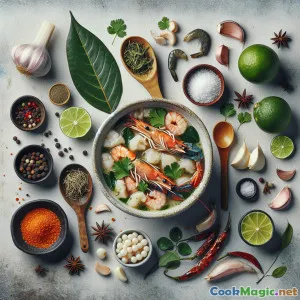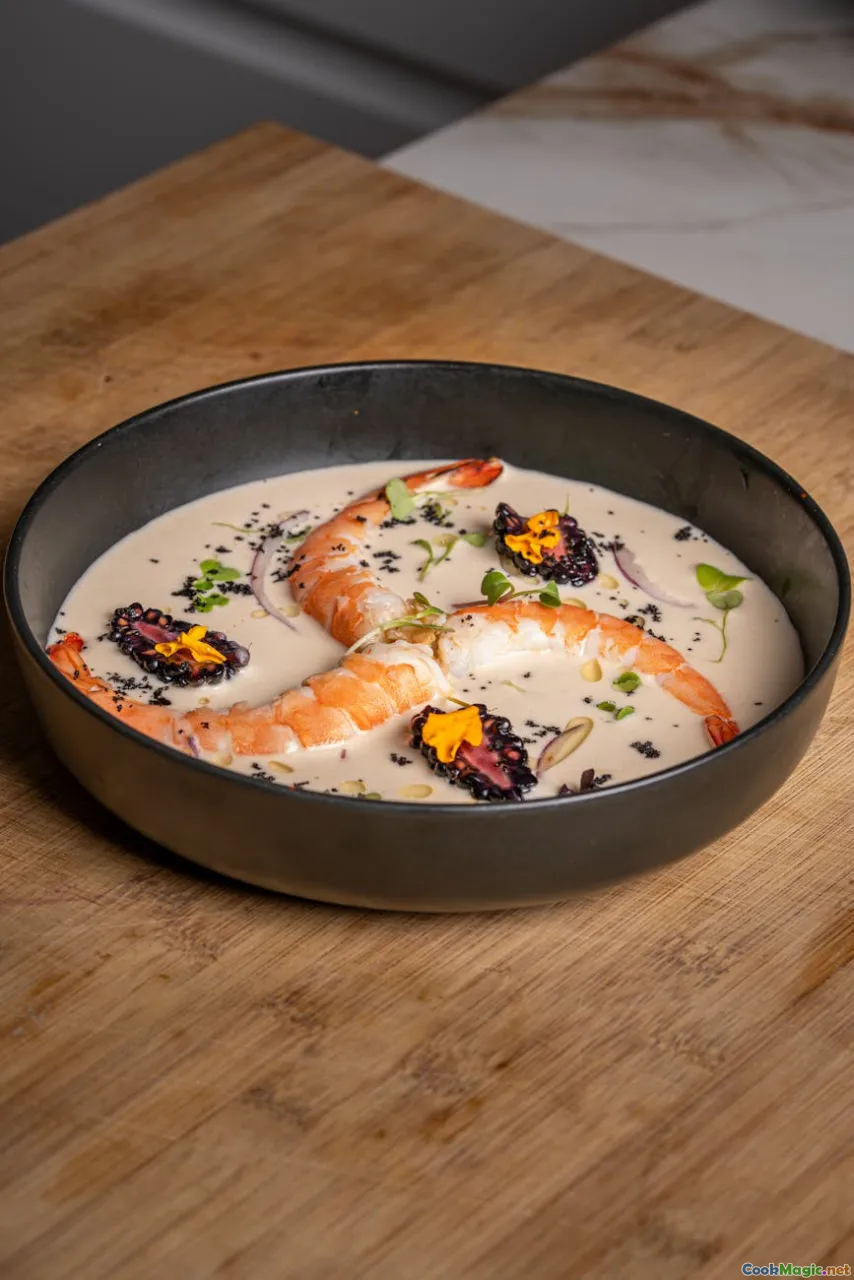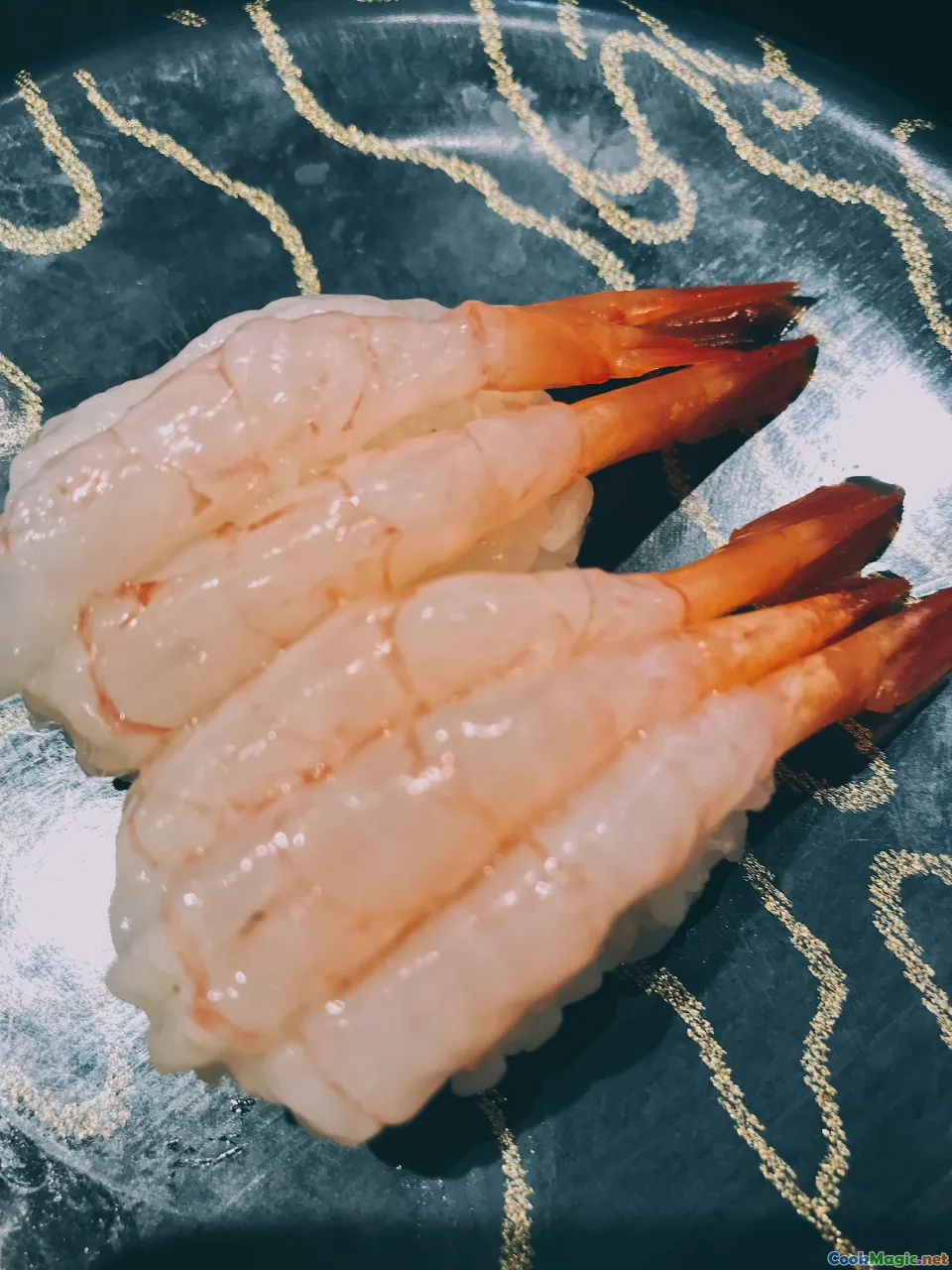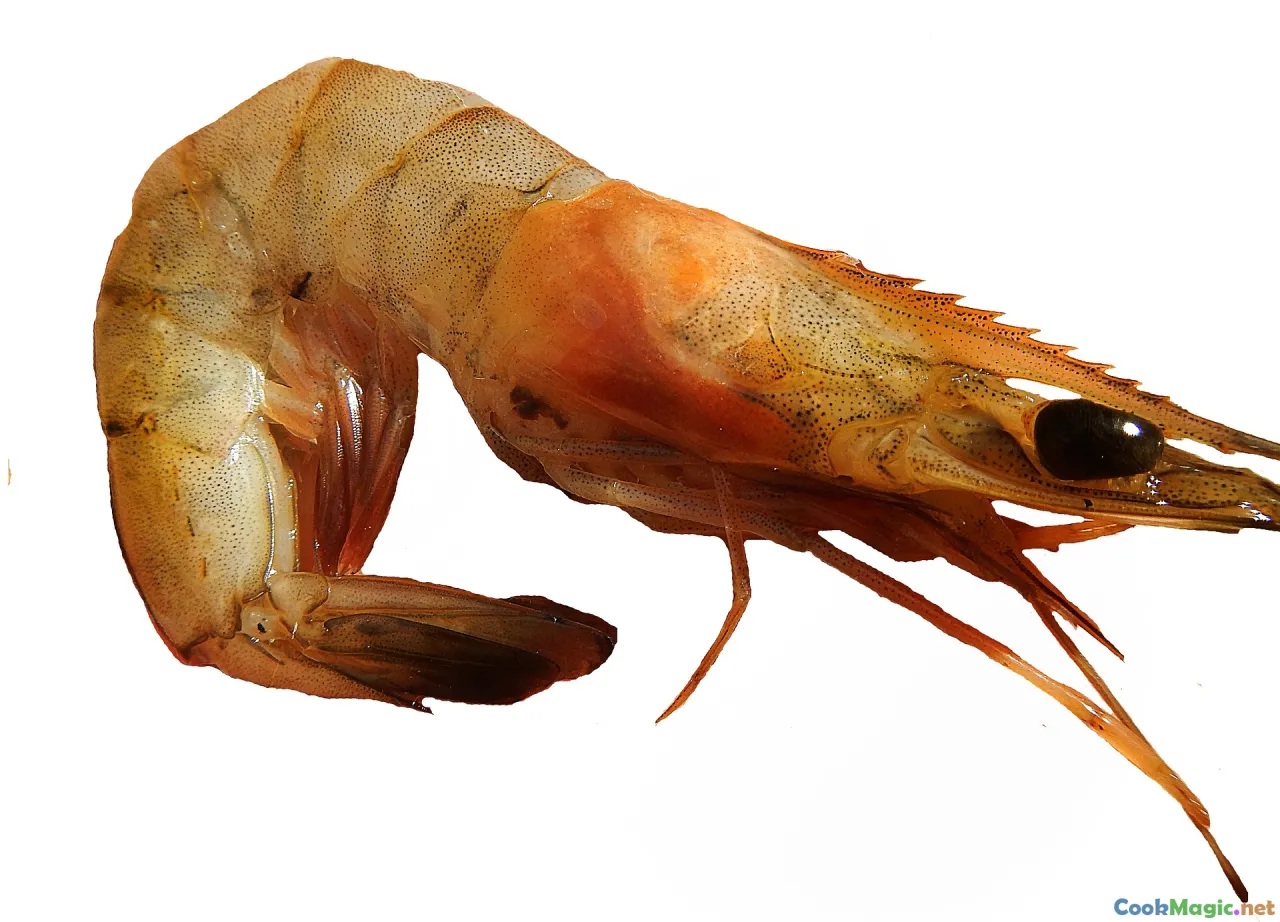
Tacacá das Águas: Sopa de Camarão Amazônica com Toque Especial
(Tacacá das Águas: Amazonian Shrimp Soup Twist)
(0 Avaliações)0
982
julho 21, 2025
Reportar um problema
Ingredientes
-
500 ml Tucupi
(caldo de mandioca fermentado amarelo (especialidade da Amazônia); pode ser substituído por um caldo de legumes rico, com 1 colher de sopa de suco de limão e 1 colher de chá de óleo de urucum, se tucupi não estiver disponível.)
-
40 grams Folhas de jambu
(Folha amazônica com efeito anestésico; substitua por agrião fresco e algumas pimentas de Sichuan para o efeito de formigamento, se o jambu não estiver disponível.)
-
150 grams Camarão de água doce ou de rio grande (com casca)
(Camarões grandes com casca são ideais. Limpe-os bem.)
-
2 tbsp Bolas de tapioca
(pérolas de tapioca pequenas, tradicionalmente adicionadas pouco antes de servir.)
-
2 medium Dentes de alho
(Finamente picado.)
-
1 small Pimenta chili seca
(Use pimenta malagueta brasileira ou substitua por pimenta malagueta.)
-
3 tbsp Coentro
(Picado, mais um pouco para guarnição.)
-
1 tsp Sal
(A gosto.)
-
1/2 tsp Pimenta preta
(Moído na hora)
-
1 tbsp Óleo de dendê (palma brasileira)
(Para cor e aroma complexo; substitua por óleo de oliva suave se não estiver disponível.)
-
1/2 whole Limão
(para acabamento e mais acidez.)
(caldo de mandioca fermentado amarelo (especialidade da Amazônia); pode ser substituído por um caldo de legumes rico, com 1 colher de sopa de suco de limão e 1 colher de chá de óleo de urucum, se tucupi não estiver disponível.)
(Folha amazônica com efeito anestésico; substitua por agrião fresco e algumas pimentas de Sichuan para o efeito de formigamento, se o jambu não estiver disponível.)
(Camarões grandes com casca são ideais. Limpe-os bem.)
(pérolas de tapioca pequenas, tradicionalmente adicionadas pouco antes de servir.)
(Finamente picado.)
(Use pimenta malagueta brasileira ou substitua por pimenta malagueta.)
(Picado, mais um pouco para guarnição.)
(A gosto.)
(Moído na hora)
(Para cor e aroma complexo; substitua por óleo de oliva suave se não estiver disponível.)
(para acabamento e mais acidez.)
Nutrição
- Porções: 2
- Tamanho da Porção: 1 tigela (350ml)
- Calories: 210 kcal
- Carbohydrates: 28 g
- Protein: 17 g
- Fat: 4 g
- Fiber: 2 g
- Sugar: 2 g
- Sodium: 970 mg
- Cholesterol: 105 mg
- Calcium: 95 mg
- Iron: 1.3 mg
Instruções
-
1 - Preparar e limpar:
Enxágue as folhas de jambu em água fria (ou use substituto de água-cress), lave e descasque os camarões, mas mantenha os rabos intactos. Reúna todos os ingredientes e pique os aromáticos.
-
2 - Cozinhe o caldo de tucupi em fogo brando.:
Numa panela média, aqueça tucupi com alho picado, pimenta (se usar), uma pitada de sal e óleo de dendê. Deixe cozinhar em fogo baixo por 10–12 minutos até ficar perfumado e reduzir ligeiramente.
-
3 - Saboreie o camarão:
Adicione os camarões e cozinhe em fogo baixo no caldo quente por cerca de 3–4 minutos. Os camarões devem ficar com uma cor rosa vivo e perfumar o caldo com um aroma saboroso.
-
4 - Finalize com folhas verdes e tapioca:
Mexa o jambu (ou substituto) e deixe murchar por 2–3 minutos. Acrescente pérolas de tapioca e leve a ferver em fogo baixo até ficarem translúcidas (5–7 minutos). Ajuste o sal e a pimenta e adicione metade do coentro picado.
-
5 - Servir e Decorar:
Divida a sopa entre as tigelas, certificando-se de que os camarões, as verduras e a tapioca estejam distribuídos. Esprema limão fresco sobre cada tigela e polvilhe com mais coentro, se desejar.
Enxágue as folhas de jambu em água fria (ou use substituto de água-cress), lave e descasque os camarões, mas mantenha os rabos intactos. Reúna todos os ingredientes e pique os aromáticos.
Numa panela média, aqueça tucupi com alho picado, pimenta (se usar), uma pitada de sal e óleo de dendê. Deixe cozinhar em fogo baixo por 10–12 minutos até ficar perfumado e reduzir ligeiramente.
Adicione os camarões e cozinhe em fogo baixo no caldo quente por cerca de 3–4 minutos. Os camarões devem ficar com uma cor rosa vivo e perfumar o caldo com um aroma saboroso.
Mexa o jambu (ou substituto) e deixe murchar por 2–3 minutos. Acrescente pérolas de tapioca e leve a ferver em fogo baixo até ficarem translúcidas (5–7 minutos). Ajuste o sal e a pimenta e adicione metade do coentro picado.
Divida a sopa entre as tigelas, certificando-se de que os camarões, as verduras e a tapioca estejam distribuídos. Esprema limão fresco sobre cada tigela e polvilhe com mais coentro, se desejar.
Mais sobre: Tacacá das Águas: Sopa de Camarão Amazônica com Toque Especial
Tacacá das Águas do Amazonas: The Enchanting Bowl of the Rainforest
Tacacá das Águas do Amazonas is more than just soup; it's a vibrant embodiment of the wild, mysterious heart of Brazil. Rooted in Amazonian culture, tacacá is a street favorite in cities like Belém or Manaus, rarely seen outside these misty regions. Crafted for the adventurous palate, this recipe pays homage to ancient indigenous traditions while adapting for modern international kitchens. Let’s dive into the river of flavors behind this truly unique bowl.
Historical and Cultural Origin
Tacacá’s history is intimately tied with Amazonia’s indigenous peoples, especially the Pará and Amazonas states. Traditionally prepared in syncretic pots and eaten with a small spoon, tacacá brings together tucupi (the fermented yellow broth of wild manioc), jambu (a native herb with a gentle anesthetic property causing a unique numbing sensation), Amazon shrimp, and the tiny chewy addition of tapioca pearls. On Sts. Nazaré procession days, crowds line up for steaming bowls; for local families, Saturdays aren’t complete without it.
This "tacacá of the Amazon’s waters" nods to the mighty rivers crisscrossing the region: the shrimp represent bounty, tucupi is the current, and leafy jambu the surrounding evergreen forest. Finding true tucupi and jambu outside Brazil can be challenging, but resourceful swaps keep the Amazon spell alive.
Unique Ingredients and Modern Adaptations
The real soul of the dish lies in tucupi—an almost mystical, bright yellow broth extracted from the toxic wild manioc root, rendered edible by confounding biochemical alchemy (boiling, fermenting, and seasoning). Its flavor profile is at once vibrant, slightly sour, and powerfully umami. Meanwhile, jambu delivers a gentle, electric tingle; chefs prize it for its "music of the mouth." Even if these rare ingredients elude you, using a rich veggie broth, a splash of annatto or palm oil, and a little citrus zest captures the essence surprisingly well. For jambu, tingly Sichuan pepper with watercress gives both botanical and sensory magic.
Shrimp, ideally wild or river-caught, define the dish’s personality—succulent and sweet. Tapioca pearls add comforting body and visually charming surprise. Additions like dende oil, cilantro, and native Amazon chilis bring jungle depth you’ll never forget.
Kitchen Tips and Notes
- Handling tucupi: Always simmer for 10–15 minutes to eliminate residual toxins and develop full flavor. Commercially sold tucupi is pre-cooked and safe, but simmering is traditional and recommended.
- Numbing mystique: Don’t worry if jambu is inaccessible—occasionally world grocers carry it frozen. Otherwise, pair fresh watercress (peppery) with 3–4 crushed Sichuan peppercorns. Taste and adjust for balance; you want more tingle than burn.
- Shrimp selection: Use wild-caught when possible. Shell-on imparts best flavor as the exoskeleton influences the rich broth.
- Tapioca pearls: These are optional; soak beforehand if using large pearls, or use pre-cooked pearls to save time.
- Street style tradition: Locals serve tacacá in calabash bowls, sometimes eaten standing on bustling Amazon street corners. Pair with cassava “biju” or crunchy breadsticks for texture.
Personal Thoughts and Experience
The first bite of proper tacacá is invigorating: tangy-salty note balanced with numbing herbal blips and juicy, just-cooked shrimp. It’s surprising—even surreal—but ultimately comforting and deeply restorative, almost like an Amazonian miso. Every detail matters—the waft of dende oil, a hit of spice, a vibrant green in every spoonful.
Embarking on tacacá is more than prepping soup—it's channeling the mighty Amazon, the gentle resilience of its people, and the breathtaking bounty of rainforest rivers. Every cook who replicates this at home, even with smart substitutes, pays IMMEDIATE tribute to a little-known gem of world cuisine. Each time you share this remarkable recipe with friends, you share not just a food but a legacy of sustainable, indigenous, nourishing joy.
Bom apetite!






















